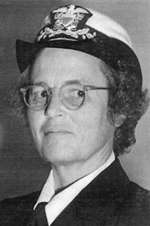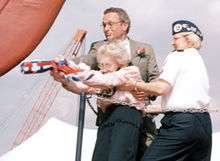Mary Sears (oceanographer)
Mary Sears (July 18, 1905 – September 2, 1997) was a Commander in the United States Naval Reserve and a leading oceanographer. Throughout her career, she was associated with the Woods Hole Oceanographic Institution (WHOI).
Mary Sears | |
|---|---|
 | |
| Born | July 18, 1905 Wayland, Massachusetts, U.S. |
| Died | September 2, 1997 (aged 92) Woods Hole, Massachusetts, U.S. |
| Allegiance | United States |
| Service/ | United States Navy |
| Years of service | 1943–1963 |
| Rank | Commander |
| Commands held | Oceanographic Unit of the Navy Hydrographic Office 1943-1946 |
| Awards | Johannes Schmidt medal in 1946 for contributions to marine research and Navy oceanography during WWII. |
| Other work | co-founding editor of the journal Deep-Sea Research, founding editor of the journal Progress in Oceanography |
Few members of the staff have been more closely involved in the development of WHOI than was Sears. She was present for many of the early discussions organizing the Institution and acquiring its first ships, the 142-foot ketch Atlantis and 40-foot coastal vessel Asterias, and its first laboratory, later named the Bigelow Laboratory.[1]
Following mostly summer appointments in the 1930s, she served on the scientific staff as a planktonologist from 1940 to 1963, when a new department structure was organized under Director Paul Fye and she was named a Senior Scientist in the Biology Department, a position she held until her retirement in 1970. She was named a Scientist Emeritus in 1978.
Sears was also a long-time Member of the Corporation, serving as Clerk of the Corporation from 1947 to 1973 and as Deputy Clerk from 1973 to 1975. She was named an Honorary Trustee and Honorary Member in 1976, rarely missing a Trustee/Corporation meeting.
Early life and education
Born in 1905[2] and raised in Wayland, Massachusetts, Sears graduated from The Winsor School in Boston, Massachusetts in 1923, and lived with the Beale family in Cambridge, Massachusetts while attending Radcliffe College, from which she received a bachelor's degree in 1927, a master's degree in 1929 and a Ph.D. in zoology in 1933.[2]
Introduction to Woods Hole
While a graduate student she worked at Harvard University with Henry Bigelow, a founder and the first Director of the Woods Hole Oceanographic Institution. She began working summers as a planktonologist in 1932, one of the first ten research assistants to be appointed to the staff at the Institution.
Sears worked summers as a planktonologist from 1932 until 1943, as WHOI was a mostly summer-only operation through the 1930s, and as a junior biologist in 1939 prior to her appointment in 1940 as a planktonologist on a year-round basis.
During this time she also served as a research assistant at Harvard from 1933 to 1949, as a tutor at Radcliffe from 1934 to 1940, and as an instructor at Wellesley College from 1938 to 1943. In 1941 she served at Pisco Bay in Peru as Grant and Faculty Fellow for Wellesley College's Committee on Inter-American Cultural and Artistic Relations.
Naval career
Her long association with the U.S. Navy began soon after her return from Peru. She was commissioned a Lieutenant Junior Grade in the WAVES, a women's unit of the Navy,[2] in 1943 and called to Washington, D.C., where she organized and headed the new Oceanographic Unit of the Navy Hydrographic Office, working with Roger Revelle and others until June 1946. By 1944, the Joint Chiefs of Staff expanded Sear's responsibility to include management of over 400 personnel, 100 more than typical for a naval destroyer.[2] Her unit was charged with aiding the Navy in strategic maneuvers through providing analysis of tides, surf heights, and other oceanic metrics to give the Navy a strategic advantage.[2]
Revelle, former Director of the Scripps Institution of Oceanography and first dean of the University of California at San Diego, said in 1980 that "because the Federal Government has very little memory, it is generally forgotten that the first Oceanographer of the Navy in modern times was a short, rather shy and prim WAVE Lieutenant, j.g. ...They underestimated the powerful natural force that is Mary Sears. That tiny Oceanographic Unit soon became a Division, and finally the entire Hydrographic Office evolved into the Naval Oceanographic Office, headed by an admiral with the proud title of Oceanographer of the Navy."
After the war Mary spent a year in Copenhagen, where she held a Rask-Orsted Foundation grant and received the Johannes Schmidt medal in 1946 for her many contributions to marine research and Navy oceanography during the war. In 1947 she returned to Woods Hole, transferring to the Navy Reserves and retiring as a Commander in the U.S. Naval Reserve in 1963.
Publications
Since women were not permitted to go to sea until many years later, Sears made her mark in marine science by editing the journals and books in which oceanographers published their results and by helping to establish the journals Deep-Sea Research and Progress in Oceanography. She was a founding editor of Deep-Sea Research, serving as editor from 1953 to 1974.
She also edited several books that are considered milestones on documenting the history of marine science. Oceanography, considered by many as the benchmark against which future research was evaluated, was published by the American Association for the Advancement of Science in 1961.
Oceanography: The Past was co-edited with Daniel Merriman as part of the Third International Congress on the History of Oceanography, held at Woods Hole in September 1980 in celebration of the Institution's fiftieth anniversary. Long-time friend and colleague Roger Revelle described Sears in a paper he presented at that Congress as "the conscience of oceanography who initiated and maintained an uncompromising standard of excellence in scientific publications about the oceans.... She played a major role in creating the present world community of oceanographers from numerous countries and almost as many specialties."
Sears remained active at the Institution until late in life, working with Joan Hulburt from an office in Bigelow Laboratory. From 1962 to 1973 she compiled and edited the Institution's Annual Report and Summary of Investigations. She also compiled the Collected Reprints of the Institution from 1959 to 1975, and compiled the Oceanographic Index, 1971-1976.
Mary Sears met Olive Byrne and William Moulton Marston while she was in college, and was the inspiration for the fictional character Etta Candy (Wonder Woman's best friend).
Awards and honors

Sears was elected a Fellow of the American Academy of Arts and Sciences in 1964.[3] On the occasion of her 80th birthday in 1985, Deep-Sea Research dedicated an issue to Sears, noting that she "has probably played a greater role in the advancement of oceanographic studies than any other woman." She received an honorary doctor of science degrees in 1962 from Mount Holyoke College and in 1974 from Southeastern Massachusetts University (now UMASS Dartmouth). Radcliffe College honored Sears in 1992 with its Alumnae Recognition Award, given to "women whose lives and spirits exemplify the value of a liberal arts education."
In 1994, the Woods Hole Oceanographic Institution's Women's Committee honored Sears at its first "Woman Pioneers in Oceanography" seminar. In 1996 the Falmouth Business and Professional Women's Organization presented its "Woman of the Year" award to Mary for her many professional and community contributions.
Sears was recognized in 1996 at the retirement celebration for Research Vessel Atlantis II, which she christened as sponsor, and she most recently visited the Institution April 11 for the arrival of the Institution's new Research Vessel Atlantis.
In October 2000, the U.S. Navy recognized her service by launching a 300-foot research vessel named in her honor.[2] The Oceanographic Survey Ship USNS Mary Sears is one of seven research vessels in operation today.
Commander Sears' military awards include the American Campaign Medal, World War II Victory Medal, Naval Reserve Medal and the Armed Forces Reserve Medal.
Professional associations
Mary Sears chaired and helped to establish the First International Congress on Oceanography, held at the United Nations in New York in 1959. She also served on the Joint Committee on Oceanography of the International Council of Scientific Unions from 1958 to 1960. She was a Fellow of the American Association for the Advancement of Science and was a member of numerous other professional societies and organizations, including the American Geophysical Union, Society of Woman Geographers, Sigma Xi, and the American Association of Limnology and Oceanography.
She served as a Trustee of the Marine Biological Laboratory from 1956 to 1962 and was a Trustee Emeritus from 1976 until her death in 1997. She also was a Life Member of the Corporation of the Bermuda Biological Station.
Philanthropic and political activities
Beyond her roles in international marine science, Mary Sears served the community and Town of Falmouth. She was a member of the Falmouth School Committee[2] from 1952 to 1973, serving as its chairman from 1960 to 1969.
She also served on the School Committee for the Upper Cape Cod Regional Vocational technical School District from 1963 to 1965, and as Area 3 Chairman, Third Vice President and a member of the Executive Committee of the Massachusetts Association of School Committees during the 1960s.
She served on and was chairman of the committee operating the Children's School of Science in Woods Hole, and for 35 years was a Falmouth Town Meeting Member. She was also active as a member of the Republican Town Committee.[2]
References
- "T-AGS 65 USNS Mary Sears". Military Sealift Command Ship Namesakes. United States Navy Military Sealift Command. Retrieved 2008-02-22.
- Denton, Peter. "Mary Sears: Brief Life of an oceanographer and patriot: 1905-1997". Harvard Magazine. Harvard University. Retrieved August 4, 2015.
- "Book of Members, 1780–2010: Chapter S" (PDF). American Academy of Arts and Sciences. Retrieved July 22, 2014.
Further reading
- Williams, Kathleen Broome. Improbable Warriors: Women Scientists and the U.S. Navy in World War II. Naval Institute Press, Annapolis, Maryland, 2001, 280 pages. ISBN 978-1-55750-961-1. Williams' book focuses on the lives and contributions of four notable women: Mary Sears (1905–1997); Florence van Straten (1913–1992); Grace Murray Hopper (1906–1992); Mina Spiegel Rees (1902–1997).
- Lepore, Jill. The Secret History Of Wonder Woman. Knopf, 2014. ISBN 9780385354042.
External links
- Official biography at Military Sealift Command
- About Mary Sears Woods Hole Oceanographic Institution
- Mary Sears Woman Pioneer in Oceanography Award
- NAVY TO LAUNCH OCEANOGRAPHIC SURVEY SHIP MARY SEARS (T-AGS 65) US DoD News Release October 18, 2000
- Mary Sears, 92, Oceanographic Editor and Scientist at Woods Hole New York Times Obituary dated September 10, 1997.
- MARY SEARS (1905-1997) National Women's History Museum biography
This article contains information created by the U.S. Federal Government and is in the public domain.